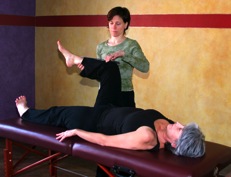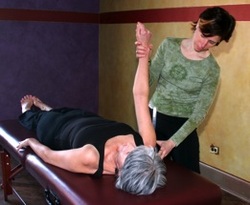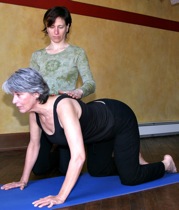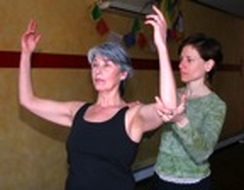Structural Yoga Therapy
PUT THE HEALING IN YOUR OWN HANDS

Bonnie Pariser is a Certified Structural Yoga Therapist. She has successfully applied Structural Yoga Therapy to alleviate the discomfort of many clients who have suffered pain due to scoliosis, back injuries, hamstring injuries, sciatica, shoulder strain, general stress and more.
The initial consult is 1 hour and 15 minutes, follow up appointments are 1 hour.
The fee for appointments is $125. E-mail and phone contact is highly encouraged during your treatment to discuss any areas of concern.
Sliding scale payments are available for those who need healing but do not have the means to pay.
Conditions that can improve with a Structural Yoga Therapy practice include
The initial consult is 1 hour and 15 minutes, follow up appointments are 1 hour.
The fee for appointments is $125. E-mail and phone contact is highly encouraged during your treatment to discuss any areas of concern.
Sliding scale payments are available for those who need healing but do not have the means to pay.
Conditions that can improve with a Structural Yoga Therapy practice include
- physical manifestations of stress
- scoliosis
- back pain
- sciatica
- sports injuries
- asthma
- MS
- neck pain
- high blood pressure
- rotator cuff injuries
- the negative effects of cancer therapies
- Structural Yoga Therapy™ adapts yoga to the client’s unique needs. It respects the body's innate capacity to recognize safe, healthy movement and healing. When health is optimal, there is a natural balance of muscle strength andrange of motion. But illness, injury and structural anomalies can disrupt that harmony. Structural Yoga therapists design a unique yoga program to address the client’s pain and discomfort brought on by body misalignment or injury.
The Role of Structural Yoga Therapy
People often approach the practice of yoga after an injury or in response to a physical problem. While yoga can be the source of relief in many instances, undertaken without consideration of the individual characteristics of the student’s body, yoga can occasionally exacerbate the very condition it was intended to heal.
As an example, many people join a yoga class because their doctors recommended yoga to ease back pain. But back pain has many different causes, and while yoga can provide relief, no single pose or movement is appropriate for all of them. Moreover, even people with the same problem may need to move in and out of the same yoga pose differently to achieve the desired result.
Many yoga teachers have not been taught to modify standard asana poses to deliver relief from pain or discomfort. The teacher may not know to ask students about their physical or structural limitations. Often the typical yoga class may be move too quickly for students in pain to protect themselves from further injury. Even if the student knows how to perform a pose the safe way, it is hard to maintain the discipline to do so when the rest of the class is moving through vinyasas quickly.
Similarly, while yoga seeks to help students achieve balanced strength and range of motion (left shoulder, right shoulder; left hip flexors, right hip flexors), many people should not practice yoga symmetrically. Although we typically think otherwise, our bodies are rarely symmetrical. To use a rather obvious and dramatic example, someone with scoliosis should perform a spinal twist toward the inside of the curvature differently than when twisting toward the outside of the curvature.
A special discipline within the field of yoga, Structural Yoga Therapy™ (SYT), addresses these issues. SYT is a therapeutic modality that seeks to alleviate injuries or structural problems (such as scoliosis or physical asymmetries) by adapting yoga poses to the individual’s unique needs.
A certified Structural Yoga Therapist is trained to evaluate individuals’ limitations and teach people who wish to develop a therapeutic yoga practice precise modifications of appropriate standard yoga poses that will be beneficial and encourage healing.
The SYT therapist is also trained to monitor the practitioner’s performance of each corrective pose, ensuring that it is done properly. The right pose done too aggressively can cause additional harm. Done too passively, the right pose may not yield intended results. Properly guided, students learn which poses strengthen or stretch various muscle groups and what the results look and feel like.
The best yoga therapists question students and clients a lot. They want to know if the student feels a pose in the right places and whether moving the body slightly one way or another will enhance the desired sensation or deliver pain. If you feel the effect of a pose in the right places, the body will heal itself more readily and you will enjoy it much more. The most successful students are those who want to know more about their bodies.
That’s the goal, of course, that students learn how best to work with their bodies. Achieving this, they can enter yoga classes and feel comfortable skipping poses they know might cause injury or just perform the pose in a personally appropriate manner — even when others in the class move differently.
Short of that, students can seek out targeted yoga classes, such as yoga for back care, yoga for arthritis, chair yoga, and other specialties. At Yoga Loka we offer those classes as well as generic Structural Yoga Therapy classes. These are attended by people with back stuff, neck stuff, shoulder stuff, hamstring injuries, sciatica and more. Other studios hold similar classes. If you have such issues, seek out a Yoga Therapist at a nearby studio and try a class.
If you take a generic yoga class, watch to see whether the teacher offers alternatives and adjustments to make sure each student feels what they should. Each student’s pose may look different from the others, but that’s just because each student’s needs are different from those of the others. After a few classes with a teacher trained in Structural Yoga Therapy, students know where they should be what their bodies should be doing.
Seek out that kind of relationship with your body. After all, you are going to be together for a long time.

The Structural Yoga Therapist
In addition to using yoga poses to strengthen and realign the body, Bonnie takes into account the client's personality, lifestyle, attitude and stress level. As necessary, she incorporates other yoga techniques such as
- identifies and eliminates problematic movements that limit range of motiondetects muscle weaknesses that contribute to imbalance
- re-educates the body to move as it was designed to move through classical yoga postures
- ensures the client understands and properly executes the postures by demonstrating the exercises and observing the client perform them
- provides handouts for home practice and encourages ongoing contact with the therapist
- periodically reassesses and adjusts the program to address changes
- encourages continued progress
In addition to using yoga poses to strengthen and realign the body, Bonnie takes into account the client's personality, lifestyle, attitude and stress level. As necessary, she incorporates other yoga techniques such as
- breathing and meditation/relaxation methods
- lifestyle adjustments based on ayurvedic therapies

Recent medical studies confirm the value of therapeutic interventions known to yogis for thousands of years. By employing these techniques, Bonnie gently invites her clients to find the personal yogic path that will carry them to spiritual growth and transformation and health

This method was created in 1976 by Mukunda Stiles, creator of Structural Yoga™, and author of the seminal book, Structural Yoga Therapy and other works on therapeutic yoga and philosophy, including Ayurvedic Yoga Therapy and the recently published Tantra Yoga Secrets. Mukunda Stiles left his body in February of 2014, but his work still shines on.
( www.yogatherapycenter.org )
( www.yogatherapycenter.org )
Training of Structural Yoga Therapists

Structural Yoga Therapists undergo a rigorous two year, 700-hour training that involves extensive studies in anatomy, biomechanics, the application of therapeutic movement, and yogic psychology, as well as the application of the more subtle aspects of classical yoga and the related field of Ayurveda. To date over 40 graduates of the training have written papers adapting SYT approaches for specific conditions. These papers are submitted to the International Association of Yoga Therapy for publication in its professional journal (www.iayt.org).
“The purpose of yoga therapy is to lead us to the Self. Once there, bliss is experienced”
-Mukunda Stiles
-Mukunda Stiles



